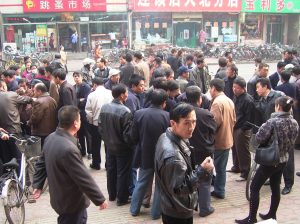Memo #135
(The fourth Memo from the Theme, Labour Migration to Northeast Asia) (Chinese translation available here)
By Biao Xiang – biao.xiang [at] compas.ox.ac.uk
 Unskilled workers from China have to pay exorbitant costs to work abroad in Japan, Singapore, and South Korea, their top three choices. Fees, averaging 8,000 USD, are not charged by human smugglers but licensed employment intermediaries. In fact, transnational labour migration through legal channels costs significantly more than illegal migration. This is not unique to China. Across Asia, the percentage of legal migrants is increasing – more than 800,000 Chinese by the end of 2011 compared to less than 60,000 in 1990. Why is the cost increasing? Because Asian states rely on intermediaries.
Unskilled workers from China have to pay exorbitant costs to work abroad in Japan, Singapore, and South Korea, their top three choices. Fees, averaging 8,000 USD, are not charged by human smugglers but licensed employment intermediaries. In fact, transnational labour migration through legal channels costs significantly more than illegal migration. This is not unique to China. Across Asia, the percentage of legal migrants is increasing – more than 800,000 Chinese by the end of 2011 compared to less than 60,000 in 1990. Why is the cost increasing? Because Asian states rely on intermediaries.
Migrants pay high costs because they pass through multiple intermediaries. Typically three to four agents, each charging a fee, are involved in placing a single worker from China to another Asian country. This multi-layered structure is a direct result of how migration is governed. The Chinese government used to place migrants directly but, in the 1980s, both China and destination states authorized a few companies as exclusive “windows” (as they are known in the recruitment business) through which labour is exported and imported transnationally. Thought to be an advantage in both market flexibility and regulation of migrants, these “windows” in China are large state-owned corporations based in big cities. They outsource recruitment to smaller agents in the prefectures, which, in turn, subcontract to rural sub-agents. Because “windows” at the top demand a fee for each job position, each layer below must draw its revenue from migrants themselves.
Multiple agents act like a chain. Not only do they conform to government regulation by recruiting the “right” migrants and producing legal paperwork, they exert control over migrants even after they depart China. Destination states hold local representatives of “ windows” accountable for any problems with brokered migrant labour. They exert pressure back through the layers of intermediaries in China, with higher levels using job opportunities (placement quotas) as leverage on lower levels. Rural sub-agents often discipline migrants transnationally by pressuring their families in China.
Because transnational labour migration in Asia is tightly controlled by states through state-owned “window” corporations, migration becomes highly profitable for multiple intermediaries. The way they make money is how China governs.
About the Author:
Biao Xiang – University Lecturer in Social Anthropology at the University of Oxford.

Laid-off state-owned enterprise employees wait for casual work. Some seek overseas jobs. Shenyang, Northeast China.
Links:
- Xiang, Biao, “Predatory Princes and Princely Peddlers: The State and International Labour Migration Intermediaries in China“, Pacific Affairs March 2012 (Forthcoming).
- Xiang, Biao, “‘Commercial Bureaucrats’: International Labour Recruiters and the States in East Asia“, Special Feature for Asia Research Institute Newsletter, National University of Singapore, March 2008.
- Xiang, Biao, “Renationalization?” TheCompasBlog, October 2011.
- Xiang, Biao, Global “Body Shopping”: An Indian Labor System in the Information Technology Industry, 2006.
Related Memos:
- Other Memos on China.
